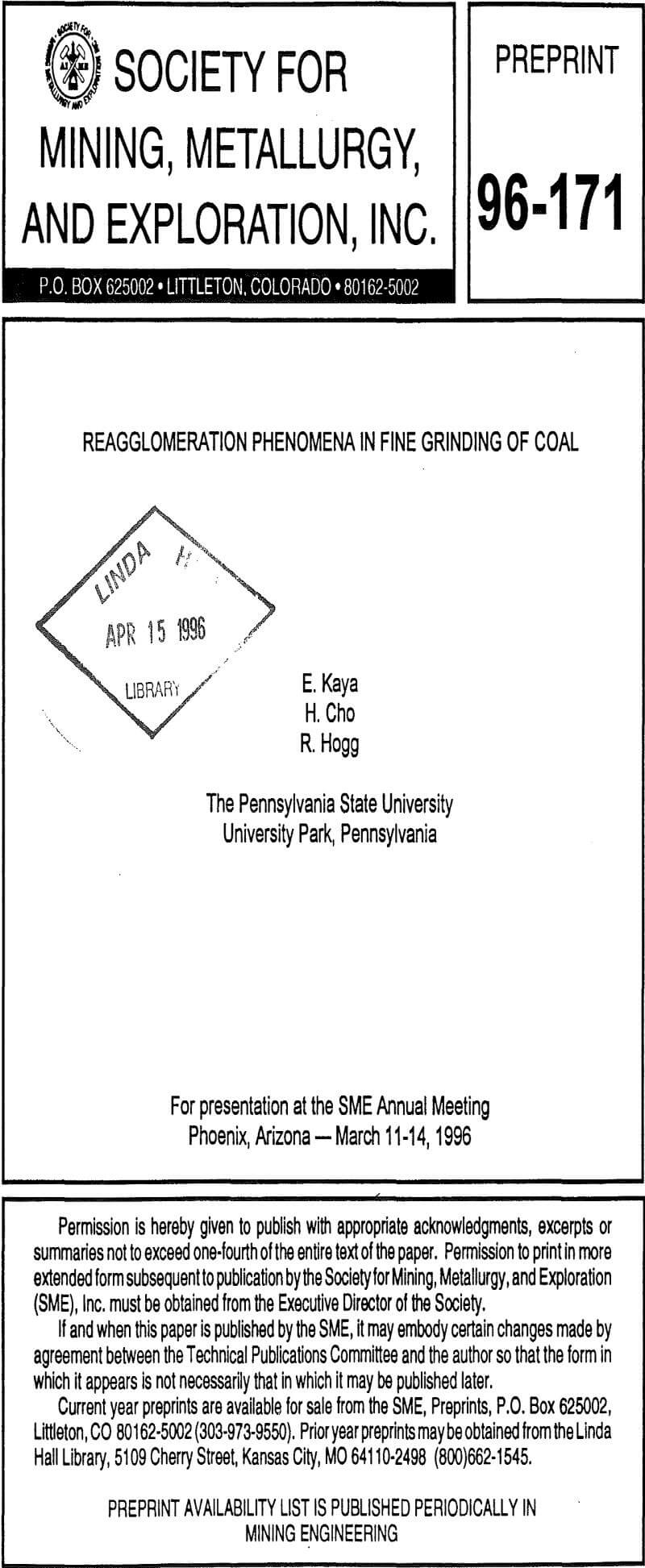 There is a growing interest in the use of fine grinding to produce ultrafine particles for applications such as direct firing of micronized coal. It has been long known that the difficulty of grinding increases dramatically with the fineness of the desired product. To some extent this is a direct consequence of the decrease in breakage rate with decreasing particle size which is generally observed for all grinding processes. However, for many systems, the effects are considerably more pronounced than would be expected on the basis of conventional grinding studies, especially in the micron and submicron size ranges.
There is a growing interest in the use of fine grinding to produce ultrafine particles for applications such as direct firing of micronized coal. It has been long known that the difficulty of grinding increases dramatically with the fineness of the desired product. To some extent this is a direct consequence of the decrease in breakage rate with decreasing particle size which is generally observed for all grinding processes. However, for many systems, the effects are considerably more pronounced than would be expected on the basis of conventional grinding studies, especially in the micron and submicron size ranges.
Various explanations have been offered for the apparent loss in grinding efficiency at very fine sizes. These include: the existence of physical “grind limits” due to the mechanics of particle fracture, the coating of grinding surfaces by fine particles, the cushioning effect of fine particles and reagglomeration of the fine material. Although, the existence of the agglomeration phenomenon has been extensively reported in the literature, attempts at quantitative analysis and modeling of simultaneous breakage and reagglomeration have been relatively rare. Such investigations as have been reported have generally been concerned with the occurrence of breakage in agglomeration processes such as flocculation rather than with reagglomeration during grinding.
Experiment
The material used for this study was a high-volatile A bituminous coal from a continuous mining operation in the Pittsburgh coal seam (Green County, PA). The coal samples were prepared for grinding using a jaw crusher and a Model 4E Quaker City mill (disk pulverizer). First, the coal samples were crushed to -½” (12.7 mm) in the jaw crusher and then to -12 US mesh (1.68 mm) in the Quaker City mill. The narrow size fractions (30×40, 70×100 and 200×270 U.S. mesh) used to obtain breakage kinetics data were prepared by screening of the -12 U.S. mesh material. The fine grinding experiments were conducted in a Bleuler, rotary ring and puck, mill (Model HNZ 1694 LA 104).

The grinding chamber in the Bleuler mill has a diameter of 14 cm and an available volume of 42 cm³. The ring has 11.9 cm outer and 9.5 cm inner diameter, the puck is 6.9 cm diameter and the chamber height is 4.6 cm. The sample size for each test was 20 g. Size analysis for product characterization was performed by dry sieving for 15 minutes for coarse sizes (+140 mesh) and 20 minutes for fine sizes (-140 mesh).
The effects of excessive grinding on the coal particles were investigated using scanning electron microscopy, SEM. Suitable samples for SEM were prepared by first dispersing the particles in a solution containing 0.1 % (by weight) of a dispersing agent, sodium-metaphosphate and 0.1 % of a wetting agent, Aerosol OT (Dioctyl Sodium Sulfosuccinate) in distilled water. The particles were deposited on a Nuclepore polycarbonate filter by vacuum filtration of one drop of the suspension. The filter and particles were gold coated for SEM examination.
The results described indicate that reagglomeration of fines can play a significant role in the production of micronized coal by prolonged grinding. Analysis of the process using a simplified population balance model including both growth and breakage terms suggests that:
- Solid particles break in a normal manner even at relatively fine sizes (< 50 µm)
- Small particles (< 20 µm) agglomerate readily and can form quite dense structures
- Large agglomerates break rapidly but small agglomerates (< 100 µm) are highly resistant to rebreakage
- Agglomerate breakage leads to considerably narrower fragment size distributions than does the breakage of solid particles.
- The combined process can be characterized by a period of net size reduction followed by one of general regrowth. Product fineness passes through a minimum after a relatively short grinding time.
It should be noted that the analysis presented here is approximate and subject to significant uncertainty due to experimental difficulties and the necessary oversimplification of the model. Nevertheless, the general consistency of the results indicates that the breakage/reagglomeration model is qualitatively valid.
The results also demonstrate the value of using a closed circuit for the production of micronized bituminous coal by dry grinding. Fine particles can be produced by grinding but they are subject to substantial reagglomeration in the grinding environment. Rapid removal of the fine product by closed-circuit grinding at high circulation ratio can minimize the deleterious effects of the reagglomeration process.
